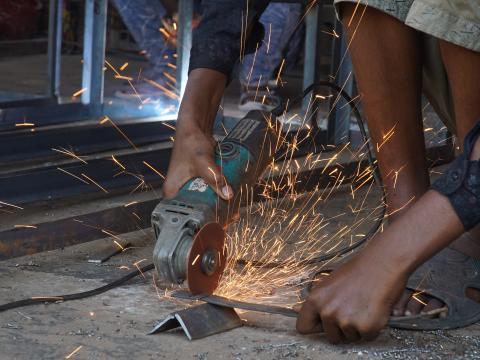Child labour, one of the most prevalent forms of violating children’s rights

By Tejan, 17, Young Leader, Sierra Leone.
I would like to give a brief insight into child labour as it’s not new to us. So, in simple words, child labour refers to the employment of children in any work that deprives them of their childhood, interferes with their ability to attend regular school, and is physically, mentally, socially and morally harmful and dangerous to children.
Although laws and regulations have been established to eradicate child labour, gaps exist within the legal framework to protect children adequately. For example, the definition of “light work” in my country’s Child Rights Act is not specific enough to prevent children from engaging in child labour as it does not provide a limit on the number of hours children can work or what constitutes “light work.”
As a result of weak national policy and social programmes, it is shocking to see that 35% of children are subject to child labour in my country, Sierra Leone. Many of these children engage in some of the worst forms of child labour, particularly in the mining sector and through commercial sexual exploitation. We also can see child labour in the agriculture sector, especially in the cultivation of cassava, coffee, cocoa etc. Within the industry sector, children work in diamond and mineral mines, quarries, and construction and manufacturing roles when they are not even physically fit to engage in such work.
Taking my community as a clear example, just imagine children having to engage in hours of farm work just after school. This is exhausting, at times, because there are not enough people to help out. Most parent often stop their children from going to school for some days, and this is how it continues - from days to weeks and extending to months during the rainy season. At the end of the farming season, children can no longer catch up with their school work, leading to dropout.
I was even a victim of child labour. I engaged in street trading in my grandparents’ village before coming to where I am now. I used to sell water and ice juice that we put in plastic bags. This affected my academic performance and I even missed one school year when I was in primary school. This stopped when my mother later brought me to stay with her, so I was then able to continue with my education. Missing one year of school resulted from extensive hours working and walking a long distance to sell the products. Just imagine what is happening to children who engage in more excessive and worst forms of child labour.
Unfortunately, street trading, amongst many other activities, is just another form of child labour that people often dismiss; they usually believe that this is a reasonable means of bringing income. However, they fail to recognise that this type of labour is awful for children and their education. Besides, child labour makes children vulnerable to other issues, such as trafficking and sexual harassment. This also places girls in greater danger than boys.
Lastly, I can say that child labour is one of the most prevalent forms of violating children’s rights. Therefore, people in power and governments should put measures in place to resolve child labour issues, not only in our country but all around the world where children are victims of child labour.